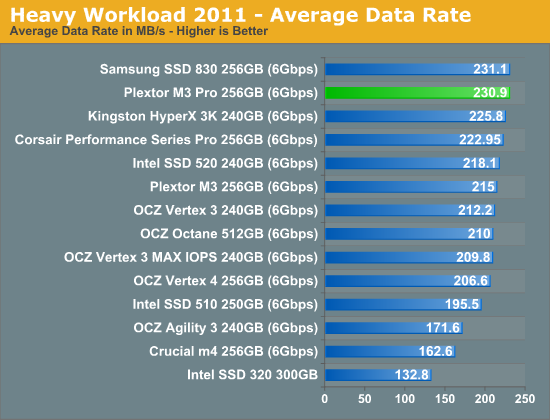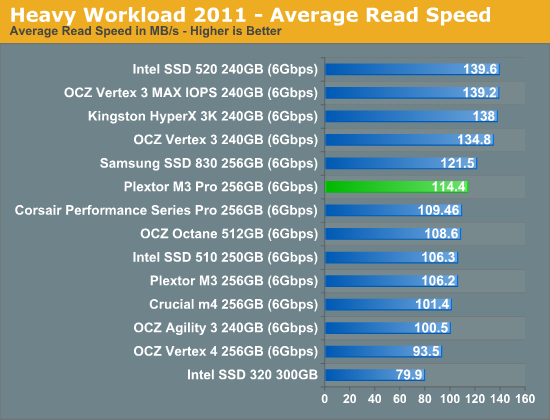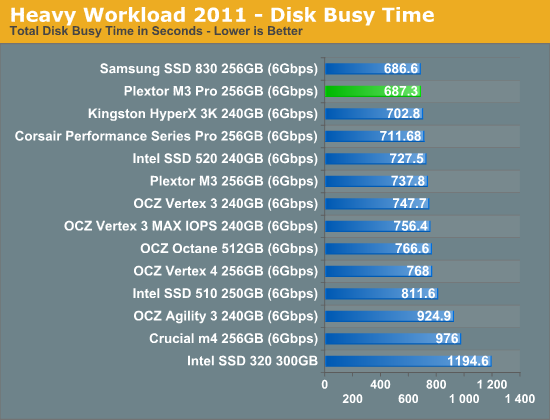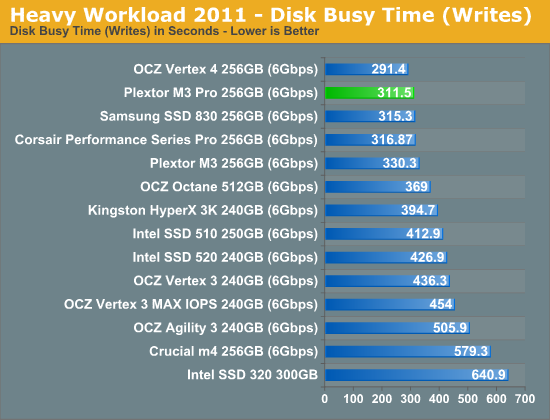Plextor M3 Pro (256GB) Review
by Kristian Vättö on July 1, 2012 1:45 PM ESTAnandTech Storage Bench 2011
Last year we introduced our AnandTech Storage Bench, a suite of benchmarks that took traces of real OS/application usage and played them back in a repeatable manner. Anand assembled the traces out of frustration with the majority of what we have today in terms of SSD benchmarks.
Although the AnandTech Storage Bench tests did a good job of characterizing SSD performance, they weren't stressful enough. All of the tests performed less than 10GB of reads/writes and typically involved only 4GB of writes specifically. That's not even enough exceed the spare area on most SSDs. Most canned SSD benchmarks don't even come close to writing a single gigabyte of data, but that doesn't mean that simply writing 4GB is acceptable.
Originally we kept the benchmarks short enough that they wouldn't be a burden to run (~30 minutes) but long enough that they were representative of what a power user might do with their system. Later, however, we created what we refer to as the Mother of All SSD Benchmarks (MOASB). Rather than only writing 4GB of data to the drive, this benchmark writes 106.32GB. This represents the load you'd put on a drive after nearly two weeks of constant usage. And it takes a long time to run.
1) The MOASB, officially called AnandTech Storage Bench 2011—Heavy Workload, mainly focuses on the times when your I/O activity is the highest. There is a lot of downloading and application installing that happens during the course of this test. Our thinking was that it's during application installs, file copies, downloading, and multitasking with all of this that you can really notice performance differences between drives.
2) We tried to cover as many bases as possible with the software incorporated into this test. There's a lot of photo editing in Photoshop, HTML editing in Dreamweaver, web browsing, game playing/level loading (Starcraft II and WoW are both a part of the test), as well as general use stuff (application installing, virus scanning). We included a large amount of email downloading, document creation, and editing as well. To top it all off we even use Visual Studio 2008 to build Chromium during the test.
The test has 2,168,893 read operations and 1,783,447 write operations. The IO breakdown is as follows:
| AnandTech Storage Bench 2011—Heavy Workload IO Breakdown | ||||
| IO Size | % of Total | |||
| 4KB | 28% | |||
| 16KB | 10% | |||
| 32KB | 10% | |||
| 64KB | 4% | |||
Only 42% of all operations are sequential; the rest ranges from pseudo to fully random (with most falling in the pseudo-random category). Average queue depth is 4.625 IOs, with 59% of operations taking place in an IO queue of 1.
Many of you have asked for a better way to really characterize performance. Simply looking at IOPS doesn't really say much. As a result we're going to be presenting Storage Bench 2011 data in a slightly different way. We'll have performance represented as Average MB/s, with higher numbers being better. At the same time we'll be reporting how long the SSD was busy while running this test. These disk busy graphs will show you exactly how much time was shaved off by using a faster drive vs. a slower one during the course of this test. Finally, we will also break out performance into reads, writes, and combined. The reason we do this is to help balance out the fact that this test is unusually write intensive, which can often hide the benefits of a drive with good read performance.
There's also a new light workload for 2011. This is a far more reasonable, typical every day use case benchmark. It has lots of web browsing, photo editing (but with a greater focus on photo consumption), video playback, as well as some application installs and gaming. This test isn't nearly as write intensive as the MOASB but it's still multiple times more write intensive than what we were running last year.
We don't believe that these two benchmarks alone are enough to characterize the performance of a drive, but hopefully along with the rest of our tests they will help provide a better idea. The testbed for Storage Bench 2011 has changed as well. We're now using a Sandy Bridge platform with full 6Gbps support for these tests.
AnandTech Storage Bench 2011—Heavy Workload
We'll start out by looking at average data rate throughout our new heavy workload test:

I think it's safe to say that the M3 Pro shares the title of the fastest drive with Samsung SSD 830 in our Heavy suite as the difference between the two is only 0.2MB/s, which is well under the margin of error between runs. When compared with the M3, the M3 Pro is 16MB/s (~7%) faster, which is quite significant when taking into account that these drives share the same hardware. Overall the M3 Pro has outstanding performance for a Marvell based drive and it actually beats all the 240GB SandForce based SSDs we have tested in overall performance for our Heavy scenario.


Looking at average read and write speeds, the M3 Pro offers middle-of-the-pack read performance while coming in near the top in read performance--second only to the OCZ Vertex 4. SF-2281 drives go the other route, with typically better read performance but lower write performance (at least with our test data that generally isn't highly compressible).
The next three charts just represent the same data, but in a different manner. Instead of looking at average data rate, we're looking at how long the disk was busy for during this entire test. Note that disk busy time excludes any and all idles; this is just how long the SSD was busy doing something:













55 Comments
View All Comments
tjoynt - Monday, July 2, 2012 - link
OT: another +1 Internet for the Lexx reference in your name. :)plext0r - Monday, July 2, 2012 - link
You guys remember MITSUMI drives? I remember they were the most sought after for a long time. I still have a Plextor SCSI CD-RW drive sitting in my parts bin. :-)Belard - Monday, July 2, 2012 - link
Yep... but it was more than JUST about speed back in THOSE days... it was about reliability of the drive and its burns.My first optical burner was from HP, it was $600 *USED!* and each blank disc was $10 each. Since I already had a SCSI controller for my $1000 HP scanner (snif - it was bad-ass) it was easy to plug and go.
The failure rates of burns on a 166mhz Pentium was about 60%... very EXPENSIVE. Doing burns required making sure NOTHING was going on in the back ground, no internet, no screen saver. A full disc burn took about 30 minutes... and yes, the drive and discs were hot.
It was years before good IDE burners came out and they were priced at about $200. Even around 2000, it made a difference to buy a $120 SONY burner vs a $75 no-name brands some of my friends would buy. ie: my burners lasted until I upgraded, vs their drives lasting months.
Nowadays, only 3-4 companies actually make burners. They have various labels on them... all of them costs about $15~24.
And yes, optical drives are STILL important and useful.
A REAL WindowsOS DVD is better than a DL version... And this is especially true with MS-Office. A disc version allows 2-3 system installs. The online version at about the same price only installs onto the PC you download it to. When that PC dies or you upgrade... well, that Office is STUCK on that computer.
rarson - Monday, July 2, 2012 - link
Optical drives are an order of magnitude cheaper than they used to be, and for the most part, far less finicky and more reliable. If you buy decent media, you're pretty much guaranteed a perfect burn even at the highest speed setting (which is also an order of magnitude faster). Capacity has greatly increased. Heck, I was just thinking about how disappointing it is that I can't fit more data on a DVD when I realized that 12X+ Blu-Ray burners are less than a hundred bucks. That's cheaper than the first CD-R and DVD-ROM drives I owned... and they read and write over a dozen different optical formats.Forgive me if I don't wax nostalgic about "the good old days." Technologically, there is no better time than the present.
Sufo - Tuesday, July 3, 2012 - link
Hah, agreed. Add to that people reminiscing about when it was still "difficult" to build PCs. It didn't require more skill, just more patience and time. I get it, you want to feel like you're actually creating your PC, not just fitting the parts together, but honestly, that all you were ever doing. There are still great hardware challenges - if anything there are more now than ever with the lowered cost of FPGAs and other integrated circuits.I'm glad that I no longer have to take risks with my expensive PC hardware - I want it to be as trouble-free and reliable as possible and I can't wait for the day when I can look back at this current gen of hardware and laugh at how slow SSDs were.
davepermen - Thursday, July 5, 2012 - link
There was a time where you could not have pc's without them. Software delivery was only trough cds, os installation, again cds. music: cds.Nowadays, you can life without them. Which i do since years. And as we go more and more mobile, they will get even less "the default source to get data from".
There was a time when 650MB was considered huge, and one could store and share everything on cds. Nowadays, not really.
Windows installs much faster from usb stick.
Software typically, when fitting on cds, gets downloaded. If it doesn't, well, still dowdnloading is the way to go, as cds don't matter then anymore anyways.
So no, they are not relevant at all anymore. They where the nr1 way to distribute data at some point in history. That point is gone.
iceman98343 - Monday, July 2, 2012 - link
kristian:when are you guys going to re-review ocz vertex 4? FW 1.5 is out.
jwilliams4200 - Sunday, July 1, 2012 - link
Finally the M3P review is posted! Thanks for the review, but hopefully Anand can get reviews posted in a more timely manner in the future (I understand that Kristian had the review done weeks ago, but Anand's policies or whatever delayed the posting of it)By the way, rumor has it that the soon to be released Plextor M5S will use the same Marvell 9174 controller, but will change to IMFT ONFi flash so it will be slower than the M3P (but presumably much cheaper).
I am hoping that Plextor is working on an M5P that will use Toshiba toggle flash and the new Marvell 9187 controller, but that is just a hope on my part. I have NOT even heard a rumor whether that is true.
Kristian Vättö - Sunday, July 1, 2012 - link
M5S is no longer a rumor: http://www.plextoramericas.com/index.php/ssd/px-m5...ONFi seems likely as sequential speeds are lower (due to less bandwidth between the NAND and controller) but random speeds are slightly higher. There is no press release about the M5S so I'm not sure if the product page has just slipped or something. I'll contact Plextor and ask what's the deal and what is the difference between M3(P) and M5S. Keep your eye on Pipeline for updates ;-)
magreen - Sunday, July 1, 2012 - link
There are only two Toolbox features I ever use for my Intel SSDs: Manual TRIM, b/c I use XP and Vista, and secure erase.Plextool doesn't do manual TRIM at all. And its secure erase is almost nonexistent b/c you need an external enclosure.
That defeats the whole point of having a toolbox, in my mind.